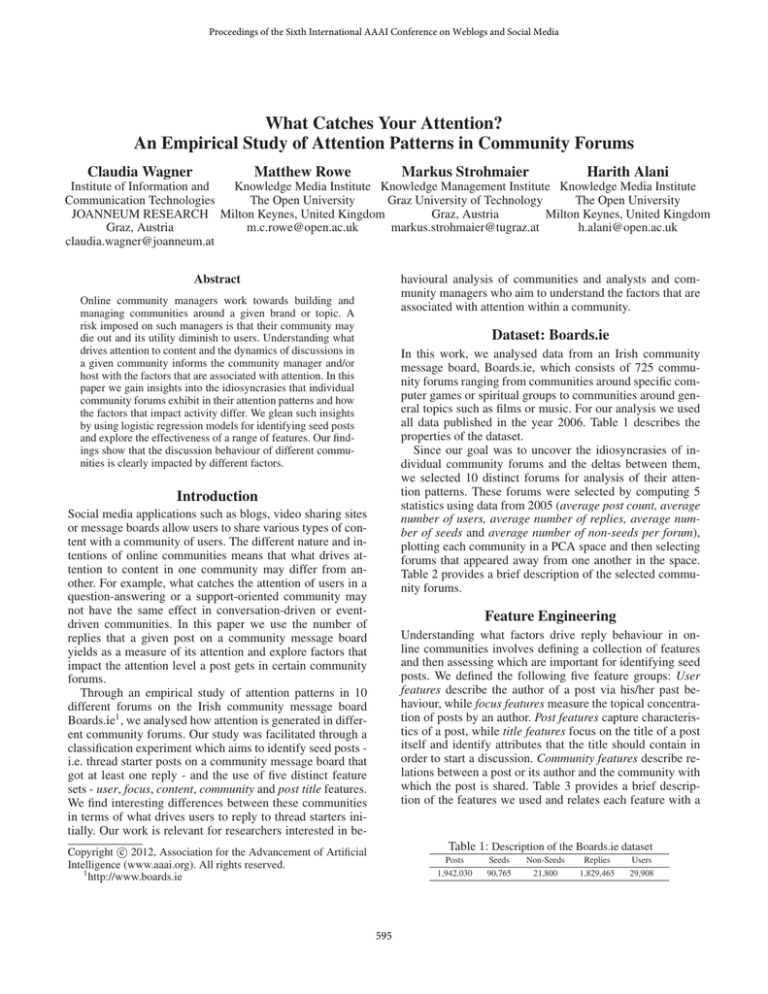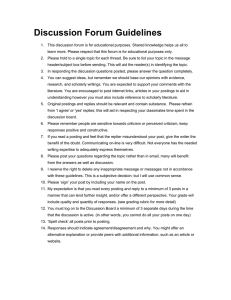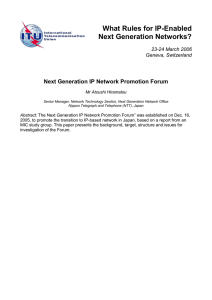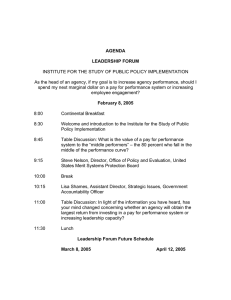
Proceedings of the Sixth International AAAI Conference on Weblogs and Social Media
What Catches Your Attention?
An Empirical Study of Attention Patterns in Community Forums
Markus Strohmaier
Matthew Rowe
Claudia Wagner
Harith Alani
Knowledge Media Institute Knowledge Management Institute Knowledge Media Institute
Institute of Information and
The Open University
Graz University of Technology
The Open University
Communication Technologies
Milton Keynes, United Kingdom
Graz, Austria
JOANNEUM RESEARCH Milton Keynes, United Kingdom
h.alani@open.ac.uk
markus.strohmaier@tugraz.at
m.c.rowe@open.ac.uk
Graz, Austria
claudia.wagner@joanneum.at
Abstract
havioural analysis of communities and analysts and community managers who aim to understand the factors that are
associated with attention within a community.
Online community managers work towards building and
managing communities around a given brand or topic. A
risk imposed on such managers is that their community may
die out and its utility diminish to users. Understanding what
drives attention to content and the dynamics of discussions in
a given community informs the community manager and/or
host with the factors that are associated with attention. In this
paper we gain insights into the idiosyncrasies that individual
community forums exhibit in their attention patterns and how
the factors that impact activity differ. We glean such insights
by using logistic regression models for identifying seed posts
and explore the effectiveness of a range of features. Our findings show that the discussion behaviour of different communities is clearly impacted by different factors.
Dataset: Boards.ie
In this work, we analysed data from an Irish community
message board, Boards.ie, which consists of 725 community forums ranging from communities around specific computer games or spiritual groups to communities around general topics such as films or music. For our analysis we used
all data published in the year 2006. Table 1 describes the
properties of the dataset.
Since our goal was to uncover the idiosyncrasies of individual community forums and the deltas between them,
we selected 10 distinct forums for analysis of their attention patterns. These forums were selected by computing 5
statistics using data from 2005 (average post count, average
number of users, average number of replies, average number of seeds and average number of non-seeds per forum),
plotting each community in a PCA space and then selecting
forums that appeared away from one another in the space.
Table 2 provides a brief description of the selected community forums.
Introduction
Social media applications such as blogs, video sharing sites
or message boards allow users to share various types of content with a community of users. The different nature and intentions of online communities means that what drives attention to content in one community may differ from another. For example, what catches the attention of users in a
question-answering or a support-oriented community may
not have the same effect in conversation-driven or eventdriven communities. In this paper we use the number of
replies that a given post on a community message board
yields as a measure of its attention and explore factors that
impact the attention level a post gets in certain community
forums.
Through an empirical study of attention patterns in 10
different forums on the Irish community message board
Boards.ie1 , we analysed how attention is generated in different community forums. Our study was facilitated through a
classification experiment which aims to identify seed posts i.e. thread starter posts on a community message board that
got at least one reply - and the use of five distinct feature
sets - user, focus, content, community and post title features.
We find interesting differences between these communities
in terms of what drives users to reply to thread starters initially. Our work is relevant for researchers interested in be-
Feature Engineering
Understanding what factors drive reply behaviour in online communities involves defining a collection of features
and then assessing which are important for identifying seed
posts. We defined the following five feature groups: User
features describe the author of a post via his/her past behaviour, while focus features measure the topical concentration of posts by an author. Post features capture characteristics of a post, while title features focus on the title of a post
itself and identify attributes that the title should contain in
order to start a discussion. Community features describe relations between a post or its author and the community with
which the post is shared. Table 3 provides a brief description of the features we used and relates each feature with a
Table 1: Description of the Boards.ie dataset
c 2012, Association for the Advancement of Artificial
Copyright Intelligence (www.aaai.org). All rights reserved.
1
http://www.boards.ie
Posts
1,942,030
595
Seeds
90,765
Non-Seeds
21,800
Replies
1,829,465
Users
29,908
dataset into a training/testing split using an 80/20% split,
trained the logistic regression model using the former split
and applied it to the latter. We tested each of the five feature
sets in isolation - i.e. user, focus, post, community and title
- such that the model was trained using only those features,
and then tested all the features combined together. The best
performing model was then chosen and the coefficients of
the logistic regression model were inspected to detect how
the features were associated with seed posts, thereby identifying the factors that impact reply behaviour of users in
different community forums.
To assess how well each model performed, we measured
the Area Under the ROC Curve (AU C). A curve that maximises the AUC, and therefore achieves AU C = 1, is optimal.
Table 2: Overview of selected community forums
ID
7
Name
After hours
9
552
Computers and
Technology
Wanted General
483
Cuckoo’s Nest
47
Motors
11
Flight Simulator
General
Wanted Tickets
556
468
TCD
411
Mobile Phones
and PDAs
453
Flight Simulator
Discs
Description
General discussion forum with the highest
level of activity on the platform.
Computer support-oriented forum containing posts enquiring about issue resolution.
Forum where users state items and products
that they would like which other users could
provide.
Conversation forum for liberally minded individuals.
Contains posts related to motoring spanning
topics such as new cars, purchasing advice
and general motoring discussion.
Community for discussions about the video
game Flight Simulator.
Forum for users to state their needs for
event tickets, ranging from sports through
to music concerts.
Forum for discussions related to Trinity
College Dublin (TCD), one of the largest
universities in Ireland.
Contains discussions related to mobile
phone issues and portable devices that are
emerging on the market. Often contains
support requests and allows users to resolve
problems they are having.
Forum for the exchange and sale of computer discs for the video game Flight Simulator.
Results: Seed Post Identification
Comparing the AUC values of different forums in Table
4 reveals interesting differences between communities and
corroborates our hypothesis that the reply behaviour of
users in different communities is impacted by different factors. While content features are most important for community forum 411 (Mobile phones and PDAs), user features are most important for the communities around forum
453 (Flight Simulator Discs) and 483 (Cuckoo’s nest). That
means that in forum 411 it mainly depends on a post and its
characteristics whether the post gets replies or not, while in
forum 453 and 483 posts are far more likely to get replies if
they were authored by certain types of users. For the communities around forum 556 (Tickets wanted), 552 (Wanted)
and 11 (Flight Simulator General), which all have relatively
low discussion levels (i.e. many posts get no replies), community features were most important for predicting which
post will get replies. It suggests that in those communities
only posts and/or users which fit into the community and/or
contribute to the community will get replies. Finally, for
the communities 7 (After Hours), 9 (Computers and Technology), 468 (TCD) and 47 (Motors), a classifier based on
all features performed best in differentiating between posts
which get replies and posts which do not stimulate any discussion.
To gain deeper insights into the factors which impact
users’ reply behaviour, we further analysed the coefficients
of the logistic regression model which indicate the features’
influence on the probability of a post getting replies. In the
following we only discuss statistical significant coefficients.
For example, when further analysing the Mobile phones and
PDAs community, for which content factors seem to play a
crucial role, we noted that in this community posts which
have a higher polarity (c = 3.14) and are therefore more
positive are far more likely to get replies. This community
seems to be mainly driven by content factors, while characteristics of authors or relations between authors and the rest
of the community play a minor role. Community 9 (Computers and Technology) seems to have a supportive purpose. Posts are far more likely to get replies if titles contain question marks (c = 0.528), articles (c = 0.0211) and
negated words (c = 0.0581) and if the post’s content has
feature group.
For each thread starter post we computed the features by
taking a 6-month window prior to when the post was made.
That means, we used all the author’s past posts within that
window to construct the necessary features - i.e. constructing a social network for the user features, assessing the forums in which the posts were made for the focus features
and inferring topic distributions per user and month based
on the content of posts he/she authored within the previous
6 month. For the features that relied on topic models, we first
trained a Latent Dirichlet Allocation (Blei, Ng, and Jordan
2003) model which we use later for inferring users’ topic
distributions. For training the LDA model we aggregated all
posts authored by one user in 2005 into an artificial user document and chose the default hyperparameters (α = 50/T ,
β = 0.01 and T = 50) which we optimised during training.
We used this model to infer the monthly average topic distributions (averaged over 10 independent runs of a Markov
chain) of users who authored at least one post in 2006 based
on all posts they authored within the last 6 months. We use
monthly-increments for scalability.
Experimental Setup
Our experiment sought to identify the factors that were associated with discussions in different communities. To that
end, we conducted binary classification experiment using a
logistic regression model and the features as described in the
previous section. For each forum, we divided the forum’s
596
Table 3: Overview of the features and their group memberships.
Group
User
User
User
User
User
Focus
Name
User Account Age
Post Count
Post Rate
In-degree
Out-degree
Forum Entropy
Focus
Forum Likelihood
Focus
Topic Entropy
Focus
Topic Likelihood
Description
Measures the length of time that the user has been a member of the community.
Measures the number of posts that the user has made.
Measures the number of posts made by the user per day.
Measures the number of incoming connections to the user.
Measures the number of outgoing connections from the user.
Measures the forum focus of a user via the entropy of a user’s forum distribution. Low forum entropy would
indicate high focus.
Measures the likelihood that the user will publish a post within a forum given the past forum distribution of the
user.
Measures the topical focus of a user via the entropy of a user’s topic distributions inferred via the posts he/she
authored. Low topic entropy would indicate high focus.
Measures the likelihood that the user will publish a post about certain topics given his/her past topic distribution.
Therefore, we measure how well the user’s language model can explain a given post by using the likelihood
measures:
likelihood(p) =
Np
X
ln P (wi |φ̂, θ̂)
(1)
i=0
Focus
Topic Distance
Post
Post
Post Length
Complexity
Post
Readability
Post
Post
Referral Count
Time in day
Post
Informativeness
Post
Community
Polarity
Topical Community
Fit
Community
Topical Community
Distance
Community
Evolution score
Community
Inequity score
Title
Title
Title
Length
Questionmark
Linguistic Dimension
Np refers to the total number of words in the post, φ̂ refers to the word-topic matrix and θ̂ refers to the average
topic distribution of a user’s past posts. The higher the likelihood for a given post, the greater the post fits to the
topics the user has previously written about.
Measures the distance between the topics of a post and the topics the user wrote about in the past. We use the
Jensen-Shannon (JS) divergence to measure the distance between the user’s past topic distribution and the post’s
topic distribution. The lower the JS divergence, the greater the post fits the topics the user has previously written
about.
Measures the number of words in the post.
Measures the cumulative entropy of terms within the post, using the word-frequency distribution, to gauge the
concentration of language and its dispersion across different terms.
This feature gauges how hard the post is to parse by humans by using Gunning fog index (Gunning 1952) which
uses average sentence length (ASL) and the percentage of complex words (PCW): 0.4 ∗ (ASL + P CW ) .
Measures the number of hyperlinks within the post.
The number of minutes through the day from midnight that the post was made. This feature is used to identify key
points within the day that are associated with seed or non-seed posts.
Measures the novelty of the post’s terms with respect to other posts. We derive this measure using the Term
Frequency-Inverse Document Frequency (TF-IDF) measure.
Assesses the average polarity of the post using Sentiwordnet.2
Measures how well a post fits the topical interests of a community by estimating how well the post fits into the
forum. We measure how well the community’s language model can explain the post by using the likelihood measure
which is defined in equation 1, where θ̂ refers to the average topic distribution of posts that were previously
published in that forum. The higher the likelihood of the post, the better the post fits to the topics of this community
forum.
Measures the distance between the topics of a post and the topics the community discussed in the past. We use the
Jensen-Shannon (JS) divergence to measure the distance between a community’s past topic distribution and a post’s
topic distribution. The lower the JS divergence, the greater the post fits the topical interests of the community.
Measures how many users of a given community have replied to a user in the past, differing from in-degree by
being conditioned on the forum. Theories of evolution (McKelvey 1997) suggests a positive tendency for user A
replying to user B if A previously replied to B.
Measures how many users of a given community a user has replied to in the past, differing from out-degree by
being conditioned on the forum. Equity Theory (Adams 1965) suggests a positive tendency for user A replying to
user B if B previously replied more often to A than A to B.
Number of words in the title of the post.
Measures the absence or presence of a question-mark in the title.
Measures the proportion of words per linguistic dimension using LIWC (Linguistic Inquiry and Word Count)
(Tausczik and Pennebaker 2010) which categorises 2300 words or word stems into over 70 linguistic dimensions.
Rather than using all 70 dimensions we chose five evocative dimensions for our analysis and derived a feature for
each one: human terms (e.g. adult, baby), anger (e.g. hate, loathe), sexual (e.g. horny, love), article (e.g. a, an) and
negate (e.g. no, not).
597
differences in terms of how attention is generated. Our results suggest understanding the purpose and nature of a community, including the specificity of its subject, seems to be
crucial for identifying the right features to anticipate community behaviour. Communities that seem to have a partly
supportive purpose (such as community 9 and 47) tend to be
content driven and such communities are more likely to reply to users who are new to the area, not greatly involved
in the community and who are seeking help by publishing a post which is about a topic which fits in the community. Communities around very specific subjects (such
as the community 468) tend to reply to users who are new
to the community and focussed, while communities around
more general subjects such as the After Hours community
(7) do not have this requirement. In communities that lack
specificity everyone can participate, but posts are required
to be rather short in order to minimise effort while still containing distinct terms in order to attract attention. We also
note that for support-oriented communities there are common patterns in the inclusion of a question-mark and complexity of the language used - requiring an wider vocabulary
of terms.
Although our work is limited to a small number of communities on one message board platform, Boards.ie, it uncovers an interesting problem: the problem of identifying the
context in which attention patterns may occur. Our results
show that the attention patterns of different communities are
impacted by different factors and therefore suggest that these
patterns may only be valid in a certain context and that the
existence of global, context-free attention patterns is highly
questionable. Our previous work in (Rowe, Angeletou, and
Alani 2011) focussed on identifying global attention patterns
and suggested that the initial reply behaviour of communities on Boards.ie tends to be driven by content-factors while
our findings show that this is only true for certain types of
communities. Our future work will explore this avenue by
comparing similar communities for the existance of similar
attention patterns.
Table 4: Area under the ROC curve (AUC) for different forums when performing seed post identification
Forum
7
9
552
483
47
11
556
468
411
453
User
0.612
0.556
0.434
0.918
0.573
0.596
0.434
0.597
0.469
0.678
Focus
0.660
0.590
0.469
0.890
0.542
0.539
0.545
0.582
0.468
0.602
Content
0.661
0.559
0.510
0.415
0.631
0.578
0.624
0.473
0.526
0.509
Commun’
0.536
0.463
0.532
0.765
0.490
0.604
0.683
0.442
0.396
0.574
Title
0.522
0.568
0.518
0.530
0.548
0.410
0.465
0.570
0.497
0.585
All
0.711
0.631
0.502
0.700
0.687
0.603
0.552
0.601
0.489
0.612
high complexity (c = 0.988), and therefore uses more expressive language. Outsiders, i.e. users which seem to be
rather new to the topic they are writing about (high topic
distance c = 0.970) and which are not really focused on this
particular forum (high forum entropy c = 0.163), are more
likely to get replies. Interestingly, long titles (title length
c = −0.0109) and long posts (c = −0.0103) have a negative impact on posts getting replies in such support oriented forums. Users who replied to many others (higher outdegree c = −0.0216) in the past are also less likely to get
replies. Similarly the community around forum 47 (Motors)
also seems to have a supportive purpose where content is
an important factor for anticipating the start of discussions.
Posts which fit into the community (high topical community fit c = 0.0758), whose title contains question marks
(c = 0.0554) and whose content contains a wider vocabulary of terms (high complexity c = 0.719) are more likely to
catch the attention of this community.
Communities oriented around a very specific subject such
as the community in forum 468 (Trinity College Dublin) are
more likely to reply to users who are new to the platform
(lower user account age c = −1.58E −5 ) and the topic of
community’s interest (high topic distance c = −3.53). The
more engaged a user is in a forum (high forum likelihood
c = 0.192) and the more positive his/her post is (high polarity c = 3.968) the more likely he/she will catch the attention of this community. This suggests that naivety of the
user plays a role, where a new or prospective student could
be asking the community for information about the university. Communities which are oriented around a more general
subject, such as the one around forum 7 (After Hours) also
require users to engage in a forum (high forum likelihood
c = 6.94) but do not require them to only focus on one
community (high forum entropy c = 0.379) in order to get
replies. New users (high topic distance c = 2.00) which have
a topical focus (low topical entropy c = −0.515) are likely
to get replies. Further, short posts (c = −0.0117) which have
high complexity (c = 0.797) are as well more likely to attract the attention of this community.
Acknowledgment
Claudia Wagner is a recipient of a DOC-fForte fellowship of the
Austrian Academy of Science. The work of Matthew Rowe and
Harith Alani was supported by the EU-FP7 project Robust (grant
no. 257859).
References
Adams, J. 1965. Inequity in social exchange. Adv. Exp. Soc. Psychol. 62:335–343.
Blei, D. M.; Ng, A.; and Jordan, M. 2003. Latent dirichlet allocation. JMLR 3:993–1022.
Gunning, R. 1952. The Technique of Clear Writing. McGraw-Hill.
McKelvey, B. 1997. Quasi-natural organization science. Organization Science 8(4).
Rowe, M.; Angeletou, S.; and Alani, H. 2011. Anticipating discussion activity on community forums. In The Third IEEE International Conference on Social Computing.
Tausczik, Y. R., and Pennebaker, J. W. 2010. The Psychological
Meaning of Words: LIWC and Computerized Text Analysis Methods. Journal of Language and Social Psychology 29(1):24–54.
Conclusions and Future Work
In this paper, we have presented work that identifies attention patterns in community forums and shows how such
patterns differ between communities. Our findings demonstrated that different community forums exhibit interesting
598





